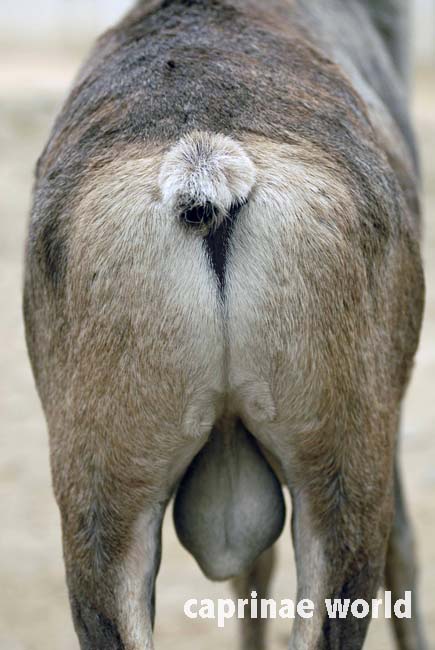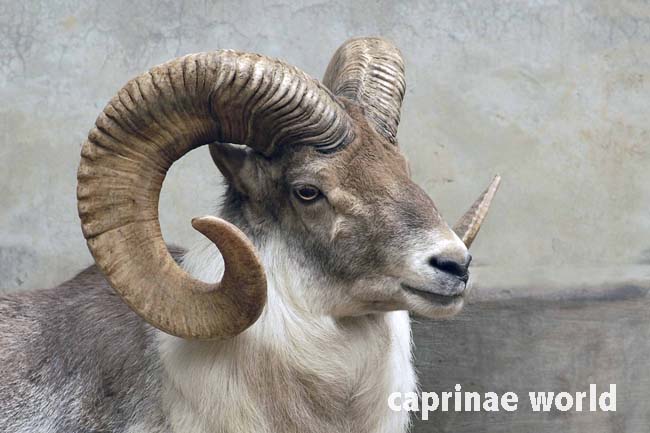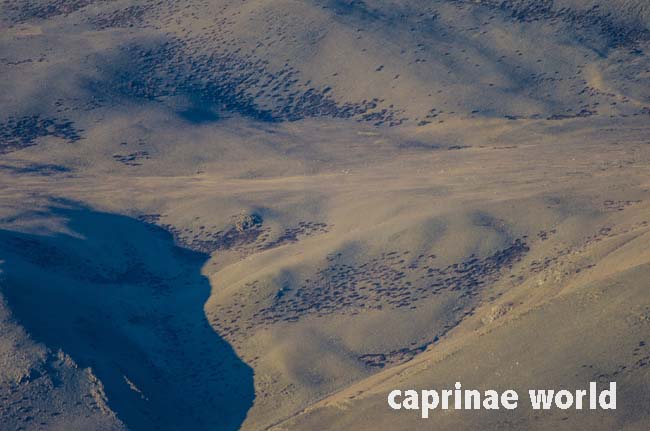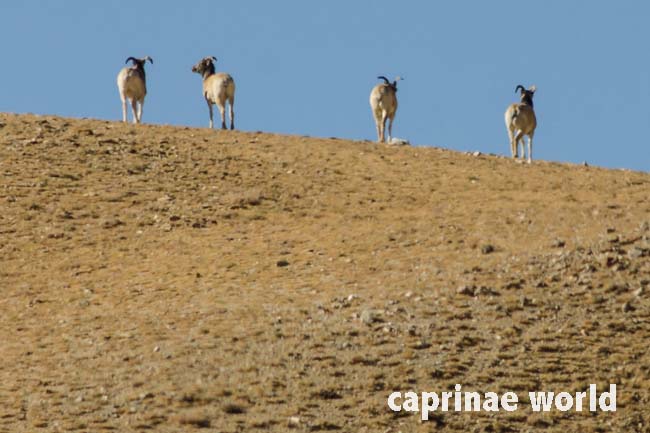The Tibetan Argali occupies the major part of the Tibetan Plateau, the largest geographic range for any specific argali type. A white ruff that surrounds the neck of males makes this species almost unmistakable.
Names
Chinese: xī zàng pán yang [1]
English: Tibetan Argali, Himalayan Argali, Nayan [1]
French: Argali du Tibet [1]
German: Tibet Argali [1]
Ladakhi: nyan (ram), nyanmo (ewe) [1]
Spanish: Argali del Tibet [1]
Tibetan: Gnyan [1]
Other (putative) scientific names and synonyms
1833 Ovis ammon Hodgson [1]
1833 Ovis nayaur Hodgson [1]
1840 Ovis hodgsoni Blyth [1]
1841 Ovis ammonoides Hodgson [4]
1852 Caprovis bambhera Gray [1]
1858 Caprovis argali Adams [1]
1873 Ovis blythi Severtzov [4]
1874 Ovis brookei Ward [4]
1888 Ovis dalai-lamae Przewalski [4]
1892 Ovis henrii Milne-Edwards [4]
1913 Ovis poli [sic] adametzi Kowarzik [4]
Taxonomy
Ovis hodgsoni Blyth, 1841. Tibet, probably on Nepal frontier [3]
This species is also classified as a subspecies of Ovis ammon. Some authors assign two argali forms to the Tibetan Plateau: hodgsoni (southern Tibetan Plateau) and dalailamae (northern Tibetan Plateau). These two forms cannot be distinguished phenotypically or karyologically. Monotypic. [3]
Similar species
Other Argalis, like Altai and Gobi Argali, are larger and have no neck ruff. [5]
Distribution
The huge range of the major part of the Tibetan Plateau occupied by the Tibetan Argali constitutes the largest geographic range for any specific argali phenotype. [1]
Countries, where Tibetan Argali occur: Bhutan, China (Xizang Autonomous Region, Xinjiang Uyghur Autonomous Region, Qinghai, Sichuan and Yunnan Provinces), India (Jammu and Kashmir, Himachal Pradesh, Sikkim), Myanmar (?), Nepal (Mustang District), Pakistan (Gilgit-Baltistan) [1]
Tibetan Plateau: Within the ranges of the Tibetan Plateau, argali are distributed discontinuously and irregularly (Liu and Yin 1993, Schaller 1998, Schaller et al. 2007, Harris 2007). Although present in ranges from the Himalaya to the Qilian Shan in Gansu, argali on the Tibetan Plateau appear to be rare where temperatures are exceedingly low, winter snows deep, and/or precipitation amounts too low to support grass (Harris 2007). However, relatively healthy populations occur in the Qilian and Kunlun Mountains of Gansu and Qinghai (although from written accounts, argali are rare in the drier, western portions of the Kunlun Shan [Feng 1990, G. Schaller, unpublished data, 2001]). Chinese sources report the species as present in extreme Western Sichuan (Wang 2002) but recent documentation of this is weak. Most authors consider argali on the Tibetan Plateau (including the Qilian Shan in Gansu) O. a. hodgsoni, although some Chinese authors consider O. a. hodgsoni limited to southern Tibet, and consider argali north of that to be O. a. dalailamae. [2]
India: Within India, argali are restricted to the eastern plateau of Ladakh, a nearby area in Spiti (Himachal Pradesh), and, separately, in northern Sikkim adjacent to Tibet (Fox and Johnsingh 1997, Bhatnagar 2003, Ul-Haq 2003, Namgail et al. 2004). [2]
Nepal: Argali are known from the Damodar Kunda area of Mustang District, bordering Tibet (Shrestha et al. 2005). They may also persist in the Dolpo region, north of the Dhualagiri Range (Wegge and Oli 1997). [2]
General discription
length / head-body: males 167 cm; females 148 cm [3]
shoulder height: males 115-118 cm [3], 107-114 cm; Lydekker (1913) states „to at least 116,8 cm [1]; females 99-112 cm [3]
weight: males 98-105 kg [3], 90-110 kg [1]; females 68 kg (one individual older than 4 years) [3],
scull length: 35,7-35,9 cm [4]
scull weight including horns: males 7,2-18 kg [3]; 12,3 kg (taken by Schaefer) [1]
horn length: males 86-145 cm and females 36-46 cm [3]
tail: tiny, about 2,5-5,8 cm [4]; males 5,5 cm [3]; 7,6 cm – one of the shortest tails in Argali [1]
life-span: probably like in other Argalis, 10-13 years (Fedosenko and Blank 2005). [2] Tibetan Argali are relatively short-lived (similar to other argalis), with rams rarely passing 10 years of age (Schaller 1998). [1]
karyotype: 2n = 56 [1]
Coloration / pelage
This species is characterised by a white ruff that surrounds the neck and is distinctly set off from the body. [3]
overall body colour: uniformly brown (no light saddle-patch between the shoulders), but in spring, the haunches appearing lighter than the torso [4] – contradicting to this statement Damm and Franco (2014, page 145) show a photo of a specimen with a whitish saddle patch; near the back they are grayish-brown and paler on the sides [3]; in old rams the back becomes grizzled, owing to the presence of white hair. [1]
lateral stripe / flank band: separating the light belly hair from the dark body hair [4]
head: white face [3]; the photos that are to hand in this chapter suggest that this is only true in females and younger males
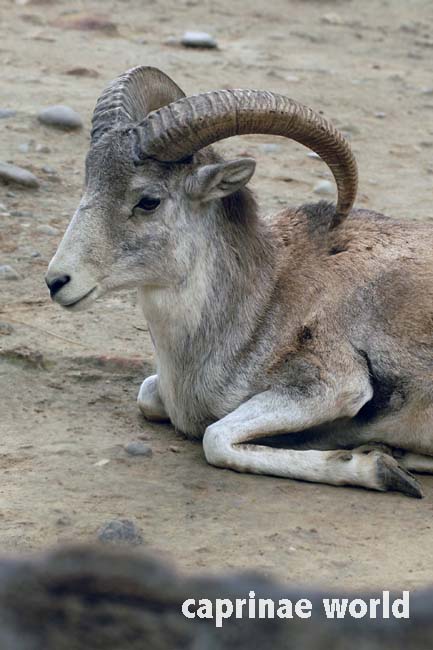
This young Tibetan Argali male still has a light face, but with some darker parts in between. Photo: Bürglin / Beijing
nuchal crest: crest of dark hair that runs from the nape of the neck to the withers. [1]
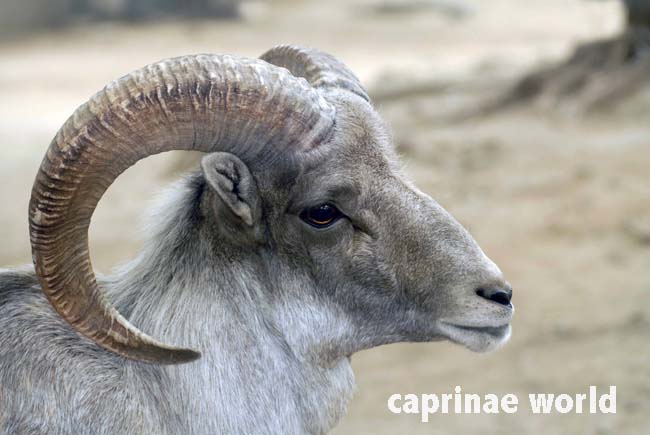
Young Tibetan Argali male with an even darker face and a nuchal crest on the back of the neck. Photo: Bürglin/ Beijing
ruff: long-haired, light-coloured [4]; not present in females [1]
underside: white [3]
rump patch: white; surrounds the tail [3]; distinctly set off in the upper parts [4]
legs: front is dark, back is white [3]
Horns
The massive horns are rather similar in length and girth to the Northern Tibetan phenotype occuring at the northern rim of the Tibetan Plateau. According to Lydekker (1898, 1900, 1913), the horns of the Tibetan rams are less massive than in the Altai Argali (O. a. ammon) [1],
horn length: males 86-145 cm [3]; females 36-46 cm [3]; mean horn length: 118,1 cm (of 43 specimens recorded between 1898 and 2000) [1]
longest recorded horn: 145 cm [3];
Table 1: Tibetan Argali – largest trophies
| length | basal horn circumf. males | tip to tip | reference |
| 145 cm | 43,0 cm | [3] reference? | |
| 140,3 cm | 47,6 cm | 73,7 cm | Rowland Ward; dates from 1898, listed under Tibet/China [1] |
| 144,5 cm | 47,6 cm | 73,7 cm | trophy of A. Pike mentioned in Lydekker: „Great and Small Game of India“ [1] |
| 50,2 cm | [1] reference? |
Only four other rams reached or exceeded 127 cm horn length. [1]
basal horn circumference: relatively massive, but less massive than in the Altai Argali [1]; males 30,4-43,0 cm and females 19 cm [3]; largest recorded at 50,2 cm; mean (males?): 43,2 cm [1] – contradicting data!
tip-to-tip spread – Tibetan specimens: 51,4 cm (n = 31); Northern Tibetan Argali: 63,3 cm (n = 4). Further research is required, before horn flare can be seen as a potential differentiating factor of the two phenotypes. [1]
horn colour: light brown [1]
spiral: less open with the descending portion nearly vertical. Horns do not exceed and often fall short of a complete circle and horn tips therefore rarely pass the eye socket [1]
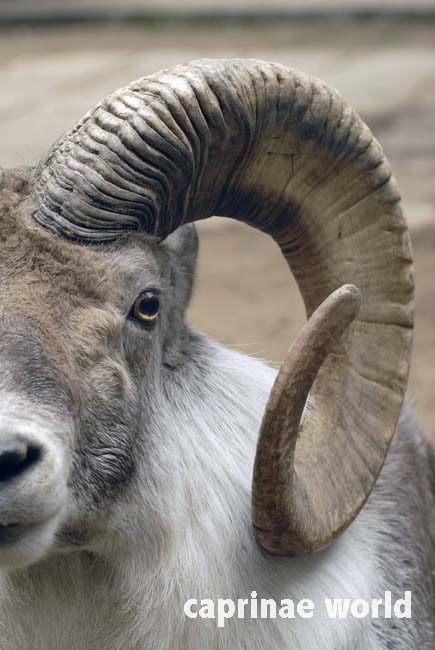
Horns of Tibetan Argali do often fall short of a complete circle. Not this one! Photo: Bürglin / Beijing
wrinkles: moderately prominent [1]
combat edge / outer front horn angle: frequently distinct [1]; in old rams less-developed than in O. pollii, less everted [4]
horn tips: usually broomed [1, 4], instead of broken. [4]
Habitat
The Tibetan Argali habitat encompasses open alpine meadows at the highest elevations of the Tibetan Plateau between 4.500 to 5.500 m. The Tibetan Plateau constitutes one of the largest arid to semi-arid wilderness areas of the world with a severe continental climate. [1]
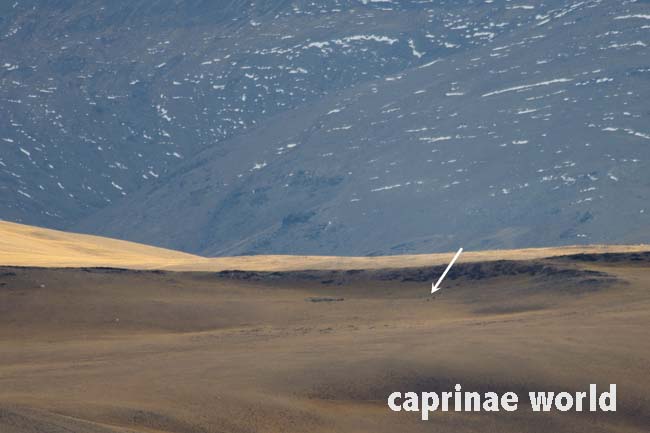
Four Tibetan Argalis at the western edge of the Tibetan Plateau at roughly 4.600 m asl in Ladakh. Photo: Bürglin
Terrain: Tibetan Argali occur on undulating or broken terrain, occasionally on upper slopes of mountains but not in rugged, precipitous areas. They are usually not found on plains or low hills, except when crossing from one mountain range to another. They use high ground such as broken, jagged cliff terrain to visually scan the landscape to detect predators and have adequate warning to outrun any threat. Even when running from a predator, they usually do not seek cover in precipitous terrain. In Ladakh, 64 percent of Tibetan Argali observations were farther than 250 m from precipitous terrain, indicating their preference for areas with gentle, slopes and away from cliffs. [3]
Snow cover is a major limiting factor in winter ranges. They require areas with minimal or patchy snow cover; areas with more than 20 cm of snow are avoided. Snow limits their ability to forage, and they are more vulnerable to predation in areas with deep snow, They occur in scattered low-density populations with a discontinuous distribution. [3]
Interspecific competition: Where sympatric with Blue Sheep (for example in Hemis Nationalpark or at Tso Kar Lake, Ladakh) they are more likely to occur in grass-dominated communities compared to the sedge-dominated communities occupied by blue sheep. [2]
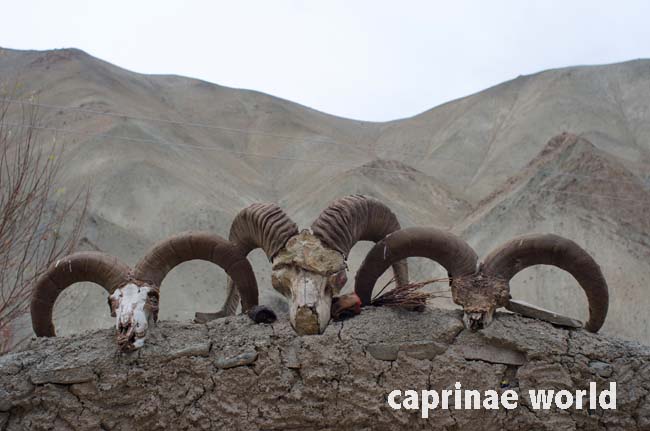
Sculls of Tibetan Argali (middle) and Bharal (left and right) on the wall of a pen in the village of Rumbak, Ladakh. Both species compete for resources – these ones not any more. Photo: Bürglin
Predators
Principal predator is the Gray Wolf (Canis lupus).
Food and feeding
Herbs, sedges, grasses and shrubs. Some studies suggest that they rely to a greater extent on forbs and shrubs (Bhatnagar 2002). [1]
in summer: principally graminoids (grasses) and forbs [3];
in winter: shrubs [3]
In Northern Nepal, Tibetan Argali diets were dominated by forbs (84,4 percent), followed by graminoids (11 percent) and browse (3 percent). They also selected for forb communities and avoided shrub communities. In Xizang, they fed principally on forbs, followed by graminoids. In Northern India, males selected sites with the highest percentage of green forage followed by non-lactating an then lactating females. [3]
Breeding
sexual maturity: Generally Argali females are sexually mature at 2 years, while males may not sexually mature until 5 years. [2]
breeding season: December to January [3]
gestation: 155-165 days [3]
lambing season: late May to early June [3]; Argali females generally separate from the herd to give birth and remain alone with their offspring for several days. Following lambing they occupy steeper (cliff) terrain. [2]
Activity patterns
Lactating females are more vigilant than non-lactating females and males. Otherwise there is no specific information available for this species, but like other argali, it is probably active throughout the day, with feeding periods alternating with resting periods. [3]
Movements, Home range and Social organisation
Although adult males and females form separate groups during non-mating periods, these two groups occupy the same habitats and segregation is spatio-temporal. [3] Herds may consist of varying sizes up to 100 individuals (Schaller 1998). [1]
Status
IUCN Red List Category: „near threatened“ under O. a. hodgsoni. [2]
China: The population size of Tibetan Argali in China is effectively unknown and no rigorous scientific population estimate has ever been attempted over the entire range. [1] Nevertheless a lot of data exists:
Wang et al. (1997) put forward estimates of 29.000-36.000 for O. a. hodgsoni in Tibet, Qinghai, and southeastern Xinjiang; although Wang [1998] subsequently wrote that such an estimate was probably a “significant overestimate”). [2]
On the Tibetan plateau, Schaller (1998) considered that “…the total number of Tibetan Argalis could be as low as 7.000”. For the Tibetan Autonomous Region, Liu and Yin (1993) estimated 5.000 argali. For Gansu, in a letter to the US Fish and Wildlife Service dated May 17, 1991, Wang Zhangyun of China’s CITES Management Office suggested that there were as many as 20.000 argali in this province alone. In Qinghai, Zheng (2003) estimated a total population for Qinghai of 3.588. Earlier, Zheng and Zhu (1990) had estimated a population size of 665 (with a 95 % confidence interval of 245) within selected study sites totaling approximately 600 km² of the Bu’erhanbuda Shan portion of the Kunlun Shan (based on 18 groups observed).
There are at least four written estimates of argali abundance in the Hashiha’er International Hunting Area of Gansu encompassing the northern slopes of the Danghenan Shan and the nearby Yemanan Shan in Subei County, Gansu. A provincial survey from 1990 estimated 1.452 argali (with unspecified confidence limits of 831-2.073; Gao Jun, Gansu Wildlife Protection Bureau, Lanzhou, unpublished data), an internal report of unclear origin estimated 1.525 (with confidence limits of 990—2.060; Zhao Lianghong, Subei International Hunting Area, unpublished data), Liu et al. (2000) cited a mean density figure of 0.482 (which is higher than either of the 2 density estimates underlying the above abundance estimates, and which equates to an abundance estimate of 4,479), and Liu (2001) estimated a population of 3.294 within Yanchiwan township (which roughly equates with the Hashiha’er hunting area boundary). All of these estimates relied on some variation of ground-based distance sampling, but in no case were sampling methods described, although Liu (2001) revealed that his density estimate was based on a sample size of 6, and the total number of animals observed was 60. A brief survey in April 1999 suggested that all these estimates were biased high (R. Harris, unpublished data). In an adjacent hunting area in Aksai county, Gansu, the 1990 provincial population estimate was 1.545 (with confidence limits of 1.127—1.963; Gao Jun, unpublished data), and the density estimate from Liu et al. (2000) suggested a population size of 3.879. In contrast, ~ 1-month-long surveys in both 2000 and 2003 with KIHA staff, focusing on what was believed to be the best argali habitat, documented 204-255 individual argali, and although some were no doubt missed, Harris et al. (2005) concluded that it was highly unlikely that the total population exceeded 500.
Due to the lacking of consistent trend monitoring, population trends in China are largely unknown. A population monitored periodically over 12 years in Yeniugou, in the Kunlun Mountains south of Golmud in Qinghai apparently declined (Harris and Loggers 2004); no marked difference in abundance was noted in a population monitored in Aksai, Qilian Mountains in Gansu (Harris et al. 2005). [2]
India: Most argali in India occur in Eastern Ladakh. Singh (2008) estimated 540 individuals in eight locations. For Sikkim the same author calculated 200 Argali. [1] Argali only occasionally move into the Spiti area / Kibber Nala of Himachal Pradesh from adjacent Ladakh (Pandey 2003). [2]
Earlier estimates by Fox and Johnsingh (1997) calculated about 200 Argali in Ladakh. Namgail (2004) counted 127 in a ~500 km² study area in the Gya-Miru Wildlife Sanctuary and adjacent Tso Kar Basin in spring 2003. Adding unpublished recent reports of an additional 120-140 argali elsewhere in Ladakh, he concluded that there might be slightly more than 200 argali in Ladakh. Namgail (2004) cautioned against interpreting these later numbers as an increase of the 200 estimated earlier by Fox and Johnsingh (1997). [2]
Nepal: Chetri et al. (2005) observed and recorded 77 argali in four herds at an altitude of ca. 5.400 m and Shah (2003) recorded two dozen at similar elevations. The total Nepalese argali population is estimated at less than 100 animals. [1]
Buthan: Tibetan Argali are said to occur also in northern Bhutan, but no records on population size and status exist. [1]
Threats
The main threats for Argali in general are over-hunting and poaching (for meat); competition, displacement and possibly disease transmission by domestic livestock; and habitat loss.
Argali appear to be extremely intolerant of human disturbance (Fedosenko 1999, Namgail 2004, Maroney 2006, Namgail et al. 2007, Harris 2007, Schaller and Kang 2008.) These threats appear to vary little among argali populations, even though habitats vary. [2]
In China, poaching has been considered to be a substantial threat (Wang et al. 1997, Schaller 1998). In the mid-1990s however, a nationwide effort to confiscate guns from pastoralists substantially reduced the weaponry available for poaching. This, together with continued efforts to publicize the national law prohibiting killing protected species, appears to have reduced poaching during the last decade or so. At the same time however, efforts to regularize and sedentarize pastoralists generally increased habitat conflicts, because pastoralists typically intensified their use of productive grasslands preferred by argali, thus displacing them (Harris 2007). [2]
Ladakh, India: Some of the strongest data suggesting interference competition from livestock as a limiting factor for argali comes from Ladakh, India, where Namgail et al. (2007) documented a group of argali shifting their habitat preference toward escape terrain and away from preferred foraging areas when livestock were present. [2]
Conservation
China: Argali are classified as a Category II “key species” under the Chinese National Wildlife Law of 1988. As such, permits to take argali must be obtained from province-level authorities. In practice, only the trophy hunting programs have procured permits to take argali under this legislation (Harris 2007). [2]
Nature reserves: Argali occur in a number of Chinese nature reserves. In Xinjiang, they occur in at least six nature reserves (Du and Zhang 2006), including Arjin Shan, Kalamaili, Source of the 2 Altai Rivers (Altai mountains), West Tian Shan, Hami Shan (Tian Shan range) and Taxkorgan (Pamirs). On the Tibetan Plateau, argali occur in the 247,120 km² Qiangtang Reserve in Tibet and the 83,000 km² Kekexili Reserve in Qinghai, as well as in scattered populations within the Sanjiangyuan Nature Reserve in Qinghai (Schaller et al. 2007). In Gansu, argali occur in Yanchiwan Nature Reserve, and may occur in the Qilian Nature Reserve. Nature reserve designation in China does not necessarily preclude habitat conflicts, as grazing, mining, and other activities often take place. [2]
Trophy hunting areas have been established with argali as the focal species. Hunting areas in Xinjiang include Baicheng, Bu’erjin, Fuyun, Hami, Hejing, Qiemo, Tacheng, Tashiku’ergan, and Tulufan counties; in Gansu in Aksai and Subei counties (Subei’s consisted of two distinct areas, the Hashiha’er area in the Qilian Mountains and the Mazong Shan area in the Gobi Desert abutting Mongolia). In addition, two hunting areas in Qinghai Province, focusing primarily on blue sheep, have argali populations: Dulan (within separate townships, Balong and Gouli) and Maduo counties.
Hunting areas in China have generally succeeded in reducing poaching and in generating some local enthusiasm for argali, but have not yet succeeded in treating habitat conflicts (Harris and Pletscher 2002, Harris 2007). [2]
India: Argali are listed as a threatened species by the Government of India and are fully protected under Jammu and Kashmir’s Wildlife Act of 1978 (Fox and Johnsingh 1997). Poaching appears to have declined in recent years (Namgail 2004), but has evidently not been accompanied by an increase in argali. Little has been done to address the likely deleterious effects of displacement increasing numbers of livestock on argali in Ladakh. Argali are rare but present in Khangchengzonga National Park in Sikkim (Sharma and Lachungpa 2003). [2]
Trophy hunting
Damm and Franco (2014) write that hunting is currently banned in China. They recommend a combination of strictly controlled hunting by visiting and local hunters, which could be an option producing beneficial outcomes from conservation, economic and socio-cultural viewpoints. Trophy hunting needs little infrastructure investment. The ecological footprint of a very restricted number of visiting hunters, as well as their impact on the socio-cultural pattern of the population, would be minimal. On the other hand sustainable hunting programs for Tibetan Argali could offer alternatives for nomadic pastoralists. They may be willing to limit livestock numbers, control poaching and assist in conservation efforts if provided with economic incentives. [1]
Ecotourism
Mammal watchers regularly report sightings from Tso Kar Lake in Ladakh, India. In China travelling the Tibetan Plateau to look for wildlife has also become more popular in recent years.
Literature Cited
[1] Damm, Gerhard R. and Franco, Nicolás, 2014: The CIC Caprinae Atlas of the World – CIC International Council for Game and Wildlife Conservation, Budakeszi, Hungary in cooperation with Rowland Ward Publications RSA (Pty) Ltd., Johannesburg, South Africa.
[2] Harris, R.B. & Reading, R. 2008. Ovis ammon. The IUCN Red List of Threatened Species 2008: e.T15733A5074694. http://dx.doi.org/10.2305/IUCN.UK.2008.RLTS.T15733A5074694.en. Downloaded on 13 June 2018.
[3] Wilson, D.E. and Mittermeier, R.A. [eds], 2011: Handbook of the Mammals of the World. Vol. 2. Hoofed Mammals. Lynx Edicions, Barcelona.
[4] Groves, Colin and Grubb, Peter, 2011: Ungulate Taxonomy. The John Hopkins University Press.
[5] Castelló, José R., 2016: Bovids of the World – Antelopes, Gazelles, Cattle, Goats, Sheep, and Relatives. Princton University Press.


